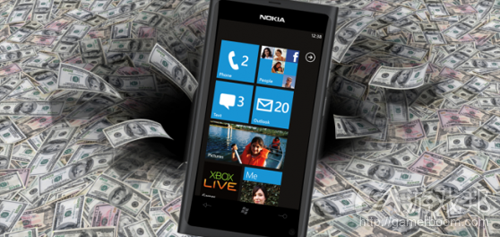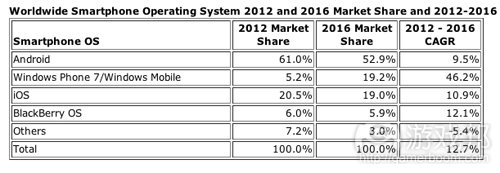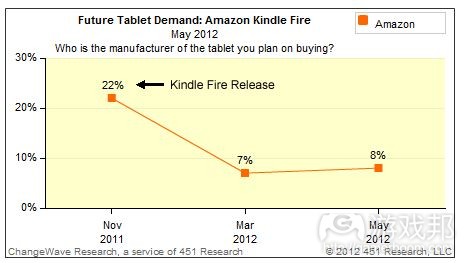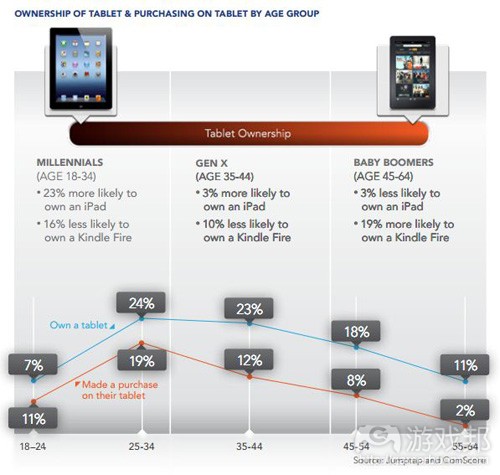每日观察:关注Kindle Fire及Windows Phone市场潜力(6.7)
1)IDC最新报告预测,2016年Windows Phone智能手机市场份额将达19.2%,届时该平台将超越黑莓和iOS,成为仅次于Android的第二大智能手机操作系统。
预计Android市场份额将从目前的61%下降至52%,但由于三星等制造商设备销量较为稳定,该平台仍将保持头号智能手机平台的地位。
2016年苹果iOS市场份额预计为19%,比今年略为下滑,因为苹果尚未成功挖掘新兴国家市场潜力。
由于智能手机价格下降及普及率增长,预计功能性手机市场份额在今年流失10个百分点。
2)ChangeWaveResearch最近发布的2012年3月份调查报告显示,亚马逊Kindle Fire在平板电脑的市场影响力正在迅速缩水:自Kindle Fire2011年11月份发售以来,用户对该设备的需求下降了14%;与此同时,却有73%受访者声称有意购买苹果iPad产品(游戏邦注:其调查样本为2800多名用户)。
报告认为其他报告指出Kindle Fire用户满意度低于iPad用户的调查结果,可能是影响用户购买意向的原因之一。此外,传说中的“iPad Mini”设备更将给亚马逊和其他Android平板电脑构成威胁。
ChangeWaveResearch称目前新iPad的最大劲敌应该是iPad Mini,但后者尚未出现,即使出现了也只会让苹果获益。
3)移动广告平台Jumptap(拥有1.07亿月访问用户)最近数据显示,Kindle Fire用户在Jumptap平台的展示广告点击率为1.02%,高于iPad用户(0.9%)。
从总体上看,平板电脑广告点击率高于智能手机,但屏幕大小并非决定广告点击率的关键因素,例如10.1英寸的三星Galaxy Tab广告点击率为0.53%,而3.5英寸的Galaxy S广告点击率也是0.53%。
Jumptap还指出,iPad用户多集中于18-34岁群体,Kindle Fire用户则多为45-64岁群体。
4)移动广告网站InMobi最新报告指出,平板电脑上的广告印象增长速度比智能手机平台快2倍,在过去6个月中,InMobi平板电脑广告印象增幅为88%,其中Anddroid平板电脑设备占比28.9%,超过2011年第四季度的18.2%,仅Kindle Fire广告印象就占比9.2%,InMobi认为Android平板电脑的快速发展很大程度要归功于Kindle Fire。
Kindle Fire是目前仅次于iPad的第二大平板电脑,排名第三的则是华硕Eee Pad Transformer,它在InMobi平板电脑广告印象中占比5.2%。
另一家移动广告公司Millennial Media最近报告也指出,非手机连网设备(例如平板电脑、电子阅读器和MP3播放器)广告印象同比上季度增长33%,其中iPad是最受欢迎的设备,其次是三星Galaxy Tab,第三是Kindle Fire。
5)迪士尼移动高级副总裁兼总经理Bart Decrem(他是Tapulous联合创始人,该工作室于2010年被迪士尼收购)在最近采访中介绍了团队开发项目的经验。
据其所称,制作《Where’s My Water?》这款游戏时,他们先确定游戏玩法机制,然后才敲定角色形象,因为他们认为游戏玩法才是第一位。
提到最近与Imangi Studios合作推出的《Temple Run Brave》时,他指出迪士尼曾推荐了多个动画角色,但Imangi认为只有Brave比较适合植入《Temple Run》,通过与第三方外包资源的合作,双方仅历时90天就制作出了这款改制游戏。
谈及未来计划,Decrem称他希望能一年发布12款游戏,再打造一些像Swampy一样的新角色。他认为公司将以免费增值游戏为未来发展方向,但也仍会推出付费产品,目前美国有四分之三的孩子是智能手机用户,迪士尼移动的目标就是制作出可覆盖10亿玩家的游戏。
6)Facebook最近发表博文宣布,公司针对Facebook移动网页版应用推出一个新支付解决方案,将原来的7个支付步骤缩减为2步。
这个运营商支付选项目前已向美国和英国用户开放服务,很快就会向全球用户推广。该服务支持应用开发者以两步操作通过用户的每月话费帐单收费,无需用户采取任何输入操作。已经绑定Facebook支付服务的移动网页开发者无需调整应用就可使用这项服务。
但观察者称,此举或让Facebook出让更多收益分成,尽管有些移动运营商愿意免除90%的运营商计费收益,但Facebook向运营商及第三方支付服务公司支付的费用,也可能让Facebook损失一半左右的收益分成。
Facebook最近已开始通过广告让移动应用实现收益,宣布广告商可选择仅运行于移动平台的广告,以便应用开发者通过Sponsored Stories获取新用户。(本文为游戏邦/gamerboom.com编译,拒绝任何不保留版权的转载,如需转载请联系:游戏邦)
1)IDC: Windows Phone to snatch second place in booming smartphone market
Ricardo Bilton
Has Android reached its peak? New information from research firm IDC indicates Google’s mobile market share growth will start to slow this year.
Instead, the new rising star of the mobile operating system world will be Windows Phone, which IDC says will command 19.2 percent of the smartphone market by 2016. With the ascent, Windows Phone will jump past the BlackBerry OS, and iOS for second place behind Android in the smartphone market.
Android’s market share is set to drop from its current 61 percent market share to 52 percent in the shift, though its position in first place will remain stable on sales of devices from companies such as Samsung.
The reasons for this shift lie in basic market-share math. As the smartphone market grows (it’s projected to jump 38.8 percent in 2012) it’s almost inevitable that smaller platforms like Windows 7 will see significant parts of that growth, IDC senior research analyst Ramon Llamas told VentureBeat.
“Even though the smartphone pie is getting bigger each year, the shares of the pie for competing platforms are going to shrink,” said Llamas.
So where does that leave iOS? Apple’s mobile OS is projected to command 19 percent of the market by 2016, a slight decrease from where it stands this year. That’s right — According to IDC, iOS’s marketshare is going to shrink by a full percent. It makes sense once you consider that Apple has yet to find a way to tackle high-growth, emerging markets.
“Until we see a shift in Apple’s subsidization policy, pricing, and availability, the iPhone will continue to be cost prohibitive for most people in emerging markets,” Llamas said.
Though we’ve speculated that the iPhone 3GS will be the key to Apple’s efforts in emerging markets, those plans, if they exist, are still in their infancy. While carriers like Cricket and Virgin Mobile have been offering pre-paid versions of the iPhone 4S, there’s still yet to be a large-scale effort from Apple to target more price conscious consumers. And if IDC is correct, that’s bound to hurt Apple in the end.
But the real loser in IDC’s projections is the feature phone market, whose share IDC says will drop ten percent this year. For that you can blame the smartphone market, to which consumers are flocking to as it becomes blissfully easy and increasingly cheap to buy smartphones.(source:venturebeat)
2)Demand for Kindle Fire falls by almost two thirds in US since launch
by Keith Andrew
Consumer interest in Amazon’s Kindle Fire appears to be falling away in the US, with a new study suggesting just 8 percent of consumers in the region plan to buy the device.
Not only does that put the Kindle Fire way behind the market leading iPad – 73 percent declaring an intention to buy Apple’s tablet – but it also means demand for the device has fallen by 14 percent since launch back in November 2011.
Kindle comedown
That’s according to numbers sourced by ChangeWave Research, which – based on a survey of more than 2,800 consumers – claims Amazon’s strength in the tablet market is fast diminishing.
“Note that the Kindle Fire launch back in November was highly successful – and at the time ChangeWave had correctly forecasted it would be the first big double-digit table contender against Apple and would wreck a major blow against other second tier manufacturers,” the firm said in its report.
“But by the time of ChangeWave’s March 2012 survey, demand for Kindle Fire tumbled.”
Not happy
The firm speculates that results from other studies suggesting Kindle Fire owners are less happy with their purchase than their iPad counterparts may be having an impact on prospective customers.
Even more of a worry for Amazon and its Android rivals, however, is the impact a potential ‘iPad Mini’ could have on their respective businesses.
“At the moment, the greatest competitive threat to the new iPad could well be the iPad Mini – which doesn’t exist yet, but even if it ever does, it too will be made by Apple,” added VP of research Dr. Paul Carton.
“When it comes to tablets, the ChangeWave survey shows Apple continuing to exert near total control over the market.”(source:pocketgamer)
3)Amazon ad happy as Kindle Fire outpaces iPad on click-through rates
by Keith Andrew
Kindle Fire owners are far more click happy when it comes to display ads than those who own an iPad according to new numbers released by Jumptap.
The network’s sweep of 107 million monthly visitors in its MobileSTAT report revealed Amazon’s tablet boasts a click-through rate (CTR) of 1.02 percent, putting it ahead of the larger
Apple iPad on 0.9 percent.
Eyes on ads
Indeed, Jumptap notes that, while tablets in general tend to deliver higher CTRs than smartphones, the success of the 7-inch Kindle Fire proves bigger isn’t always better when it comes to grabbing user attention.
“Screen size isn’t always a predictor,” the firm stated.
“For example, the Samsung Galaxy Tab (0.53 percent), Note (0.58 percent), and Galaxy S (0.53 percent) all had comparable CTRs despite having three very different screen sizes, ranging from 10.1 inches to 3.5 inches.”
Age is everything
Further delving into the tablet market, Jumptap claims combining its data with numbers from comScore shows the userbases of the two tablets differ wildly.
The company states 18-34 year old are more likely to use an iPad, while older ‘baby boomers’ are more drawn more heavily to Amazon’s Kindle Fire.
“What makes the mobile market thrive are the various features, functionalities and form factors of each device,” added CMO Paran Johar.
“In order to capitalise on that notion and increase campaign CTR, advertisers should build creative that reflects the unique aspects of each device, in accordance with the Mobile Marketing Association and Interactive Advertising Bureau guidelines.”(source:pocketgamer)
4)InMobi: Tablet impressions grow 88% in six months as the Kindle Fire pulls even further ahead in the Android tablet race
Kathleen De Vere
Advertising impressions on tablets are growing twice as fast as they are on smartphones, according to mobile advertising network InMobi.
Over the last six months InMobi has seen the number of tablet impressions grow by 88 percent on its network. Android devices now account for 28.9 percent of all tablet impressions the company serves, up from 18.2 percent in Q4 2011.
InMobi credits the growth in Android tablets almost entirely to the success of Amazon’s Kindle Fire, which alone accounts for 9.2 percent of impressions. The Kindle Fire is the second most popular tablet in the market, behind Apple’s iPad. The third most popular tablet is the Asus Eee Pad Transformer, which accounts for just 5.2 percent of InMobi’s tablet impressions.
Overall, InMobi’s numbers echo the results of another mobile advertising company’s latest study. Competitor Millennial Media’s latest Mobile Mix Report noted impressions on non-phone connected devices (i.e. tablets, e-readers and MP3 players) were up 33 percent quarter-over-quarter. In that category, Millennial reported the iPad was the most popular device, followed by the Samsung Galaxy Tab, with Amazon’s fast-growing Kindle Fire taking the No. 3 spot.
With two of the biggest independent mobile advertising networks both highlighting the growth of the Kindle Fire’s market share among Android tablets, it’s safe to assume if Amazon’s device can continue its momentum it will split the Android market, making Amazon App Store the best way to reach Android tablet owners. With developers like Crowdstar and TinyCo reporting the Amazon App Store is capable of delivering higher average revenue per user that both Google Play and the iTunes App Store for iPad, it seems prudent for Android developers to begin exploring their options on Amazon if they wish to participate in the Android tablet market at all.(source:insidemobileapps)
5)Disney Mobile’s Bart Decrem on passion, characters, and building a mobile game for a billion players
by Jon Jordan
It’s become fashionable for social-mobile companies to say they’re gunning for an audience of 1 billion gamers.
Zynga cited the number when launching its online platform, and it’s the stated aim for Japanese outfit GREE too.
To hear the number from the mouth of Disney Mobile’s Bart Decrem is perhaps a little more surprising, but there’s no doubt about his commitment to the goal.
“When I came to Disney, it was to bring entrepreneurial activity and passion,” say’s Disney Mobile’s SVP and GM of the deal that saw the company he co-founded, Tap Tap Revenge developer Tapulous, acquired in 2010.
Cleaning up
Since then, Disney Mobile has stepped up its operations, scoring a notable hit with puzzler Where’s My Water?, and creating a strong character in the form of bathing crocodile Swampy.
“We started with a gameplay mechanic and we ended up with a character,” Decrem says about the process.
For despite what would seem to be the Disney way of coming up with characters and then putting them into games, he argues that it has to be about the game first.
“Our approach is can we build great games?” Decrem says. “Can we create games that people use for a long time, and build a network, and build franchises.”
With three development teams in the US and Europe, Disney Mobile doesn’t lack for resources. Decrem argues its success to-date has been about combining the best of his previous indie development experience with the corporate firepower that can turn a hit like Where’s My Water? into a worldwide franchise, as is now happening in terms of Asia localisation of the game and its merchandising.
“Disney is aggressive in this market. We have the power and we can be scrappy,” he says.
Keep on running
One example of this high-low approach is Temple Run Brave.
Based the massively successful 3D runner from Imangi Studios, the all-new version is based around the character from the forthcoming Pixar film.
“We’d been talking with Imangi for a while about what we could do in terms of Disney characters. We had some thoughts, but they didn’t think they fitted. They suggested Brave,” Decrem reveals.
Despite it being a very tight turnaround, the two companies, together with a third outsource resource created the game in 90 days.
“We outran them,” Decrem laughs. “Keith and Natalia [Imangi] didn’t even think we could get the legals done in that time.”
New horizons
As for his future plans, Decrem is forthright.
“I want to release 12 games a year. I want one new character like Swampy. We need to be taking chances with new characters.
“Once a year, I want to make a game based around an event, like Brave. And I want to bring existing Disney characters into new games,” he says.
The focus of the company going forward will be with free-to-play titles, although where appropriate, there will still be paid releases.
For example, Temple Run Brave will be launched at 99c, with players getting 25,000 in-game currency coins so they can experience how the extensive in-game store works.
“The power of free-to-play is that you can build a business while introducing new characters to a very large audience,” Decrem explains.
An important part of this approach is that it widens the appeal of Disney games to its core youth audience, who are more likely to be restricted in terms of access to paid games.
“Three quarters of US kids have smartphones. Mobile is their first screen,” Decrem ends.
“Our goal is to build a game that reaches one billion players.”(source:pocketgamer)
6) Facebook rolls out 2-step payments flow for mobile web apps
Brittany Darwell
Facebook today begins rolling out a new mobile payments flow that brings the number of steps down from seven to two, the company said in a blog post.
The new carrier billing option, announced in February, is now live for the U.S. and the U.K., but will be available worldwide soon. Mobile app developers will be able to charge their players’ monthly phone bills in only two steps and without requiring users to type anything. Having a fluid payments flow could encourage developers to focus more attention on HTML5 applications than they have in the past.
Mobile web developers who already integrate Facebook payments don’t need to make any changes to their apps. Those who want to use Credits on their mobile website can use Facebook’s Payments API. Developers can see an example of the payments flow in Gamzee’s Skyscraper City.
Sprint, AT&T, T-Mobile, Vodaphone, Orange, O2 and Three will support mobile payments for users in the U.S. and the U.K. A list of participating carriers by country is available here. Though it’s hard to be sure exactly what percentage of its revenue share Facebook is giving up to facilitate the new payment option, the company could be losing a substantial portion of its 30 percent cut. Earlier this year Ray Anderson, the chief executive of carrier billing company and Facebook service partner Bango, revealed carriers often provide large companies like Facebook with much more favorable carrier billing terms than smaller players receive. However, even with some carriers now remitting 90 percent of carrier billing revenue, by the time Facebook pays the carrier and any third-party payment processers, it could be losing up to half its share. We suspect the company is willing to make the sacrifice to bolster HTML5 applications and work around the barriers Apple and Google have set up to prevent Facebook from monetizing native apps that integrate its platform.
The social network is also beginning to monetize its own mobile app with advertising. On Tuesday the company announced that advertisers can now choose to run mobile-only ads, which introduces new opportunities for app developers to acquire users with Sponsored Stories.(source:insidemobileapps)















































 闽公网安备35020302001549号
闽公网安备35020302001549号